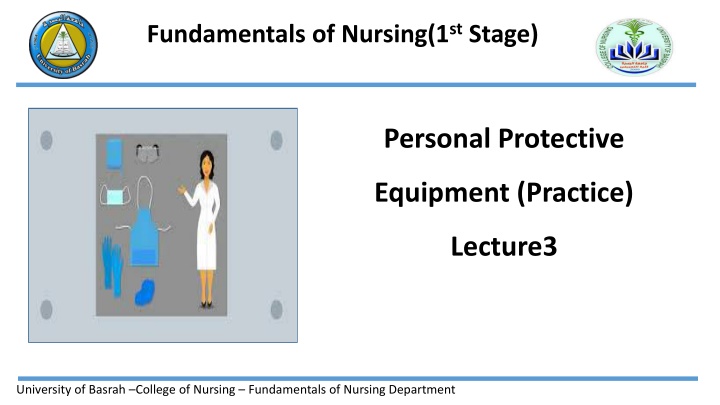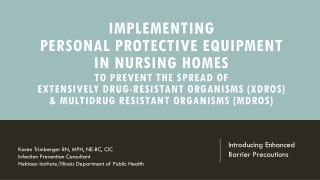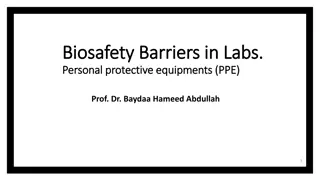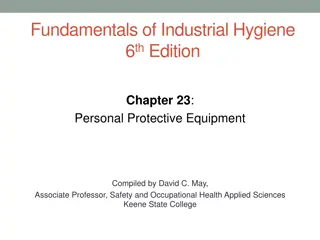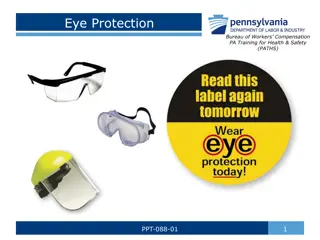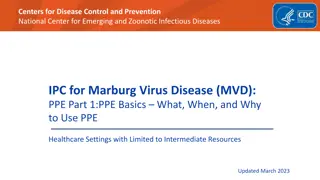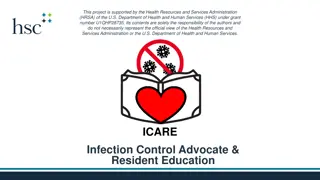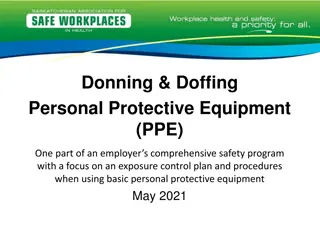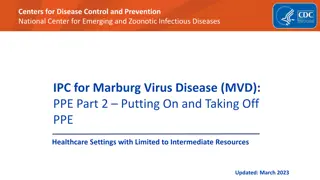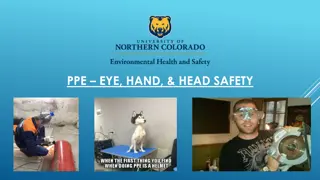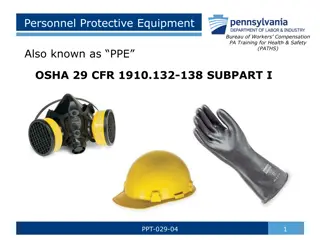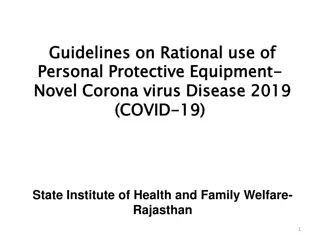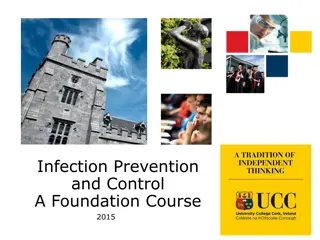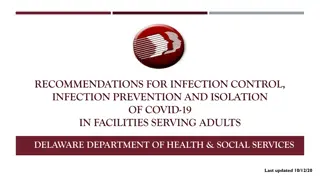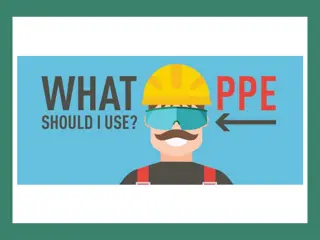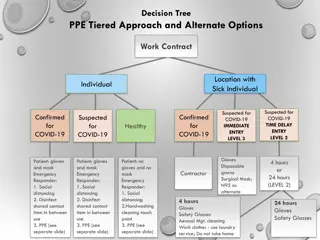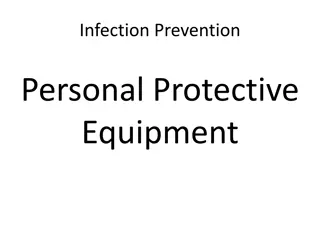Personal Protective Equipment (PPE) Practices in Nursing: Ensuring Safety and Infection Control
Discover the essential Personal Protective Equipment (PPE) items used by healthcare workers to safeguard against harmful agents. Explore the significance of proper footwear, head covers, masks, and protective eyewear in maintaining a safe healthcare environment. Learn how to correctly wear and remove masks for optimal protection. Enhance your understanding of PPE practices to uphold safety standards in nursing settings.
Download Presentation

Please find below an Image/Link to download the presentation.
The content on the website is provided AS IS for your information and personal use only. It may not be sold, licensed, or shared on other websites without obtaining consent from the author.If you encounter any issues during the download, it is possible that the publisher has removed the file from their server.
You are allowed to download the files provided on this website for personal or commercial use, subject to the condition that they are used lawfully. All files are the property of their respective owners.
The content on the website is provided AS IS for your information and personal use only. It may not be sold, licensed, or shared on other websites without obtaining consent from the author.
E N D
Presentation Transcript
Fundamentals of Nursing(1st Stage) Personal Protective Equipment (Practice) Lecture3 University of Basrah College of Nursing Fundamentals of Nursing Department
Introduction Personal protective Equipment (PPE) items are the protective barriers used by a health care workers to protect mucous membranes, airways, skin, and clothing from contact with harmful or infectious agents.
1- Footwear Proper footwear decreases the risk of exposure to blood or other potentially infectious materials, sharps injuries, and slipping or falling. All footwear should have closed toes, low heels, and nonskid soles.
Cover shoes Footwear
2- Head cover/caps Head covers or caps are most often worn during surgery and in procedure areas where a sterile field is required. They are not necessary for most other areas in the health care facility. How to wear head cover/caps Caps must cover all hair, and jewelry must be removed or contained within the head covering.
3- Mask When to wear mask 1. To protect health care workers from contact with infectious materials from patients. 2. To limit potential dissemination of infectious respiratory secretions from patients with suspected or confirmed infection who are coughing or sneezing. 3- To protect patients from exposure to infectious respiratory secretions from the mouth and nose of the health care workers during procedures that require sterile techniques.
How to wear and remove a mask Put on a new mask every time a different patient is treated: 1. Place the mask over the nose and cover the nose, mouth, and chin. 2. Fit the flexible nosepiece over the bridge of the nose. 3. Secure it on the head with ties or elastic. 4. Adjust to fit. 5. When removing, handle masks by the strings because the center of the mask contains the most contamination
4- Protective eyewear Types of protective eyewear There are four different types of eye protection that are effective in preventing infection in health care facilities: 1. Goggles 2. Safety glasses 3. Masks with attached shield 4. Face shields
When to wear protective eyewear Protective eyewear is used to shield eyes and the surrounding skin from potential risks of a splash or spray of blood and body fluids during patient care or waste disposal 1. As part of Standard Precautions 2. As part of Droplet Precautions to protect from respiratory secretions 3. During procedures and surgery when splashing is likely to happen 4. During specimen collection
5- Gowns Gowns should fully cover the torso, fit comfortably over the body, and have long sleeves that fit snuggly at the wrists. There are three types of protective gowns used in health care facilities: 1. Isolation gowns 2. Surgical gowns 3. Coverall suits
When to wear gowns 1. Gown is worn if blood or body fluid contact, spills, or splashes onto clothing is anticipated. 2. Gown is used to prevent transmission of an infectious agent that cannot be prevented by standard precautions alone. 3. Sterile surgical gown is worn to protect the sterile field and the clothes of the scrub team or those performing the procedure.
How to wear gowns Full coverage of the arms and body front, from the neck to the mid-thigh or below, will ensure that clothing and exposed areas of the upper body are protected. 1. Unfold the gown and insert both hands in the sleeves of the gown, one after the other. 2. Secure both sides using the tie at the neck and at the waist. Make sure that you tie the waist knot on the side so that it is easy to untie at the time of removal.
Removing the gowns 1. Release the knot around the neck, being sure not to contaminate the neck, followed by the side knot. 2. Slowly pull the gown away from body, pulling it inside out, as you remove your hands, one after the other. 3. Fold the gown inside out, ensuring that you avoid touching the outer surface of the gown. 4. Dispose of the gown in a contaminated-waste container.
6- Gloves Types of gloves 1. Sterile gloves are used when performing invasive medical or surgical procedures when sterility is required. 2. Non-sterile gloves are used by health care workers to protect themselves from blood and body fluids when performing routine patient care.
Applying gloves 1. Carefully open the inner package. Fold open the top flap, then the bottom and sides. 2. Take care not to touch the inner surface of the package or the gloves. 3. With the thumb and forefinger of the non dominant hand, grasp the folded cuff of the glove for the dominant hand, touching only the exposed inside of the glove.
4- Keeping the hands above the waistline, lift and hold the glove up and off the inner package with fingers down. 5- Carefully insert dominant hand palm up into glove and pull glove on. Leave the cuff folded until the opposite hand is gloved. 6- Hold the thumb of the gloved hand outward. 7- Place the fingers of the gloved hand inside the cuff of the remaining glove. 8- Lift it from the wrapper, taking care not to touch anything with the gloves or hands.
9- Slide the fingers of one hand under the cuff of the other and fully extend the cuff down the arm, touching only the sterile outside of the glove. 10- Repeat for the remaining hand. 11- Adjust gloves on both hands if necessary, touching only sterile areas with other sterile areas.
Removing gloves 1. Use dominant hand to grasp the opposite glove near cuff end on the outside exposed area. Remove it by pulling it off. 2. Hold the removed glove in the remaining gloved hand. 3. Slide fingers of ungloved hand between the remaining glove and the wrist. 4. Take care to avoid touching the outside surface of the glove. Remove it by pulling it off, and securing the first glove inside the second
Sequence for Putting On PPE 1. Put on non-skid, low-heel shoes. 2. Perform hand hygiene. 3. Put on head cover 4. Put on a surgical mask 5. Put on goggles or face shield. 6. Perform a surgical hand scrub using soap and water 7. Put on a sterile surgical gown without contamination 8. Lastly, put on sterile surgical gloves
Sequence for Removing PPE 1. Remove the gloves 2. Remove the gown 3. Remove eye protection. 4. Remove the surgical mask. 5. Perform hand hygiene. 6. Remove the head cover 7. Remove cover shoes
